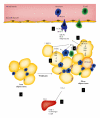Inflammatory concepts of obesity
- PMID: 21837268
- PMCID: PMC3151511
- DOI: 10.4061/2011/529061
Inflammatory concepts of obesity
Abstract
Obesity, long considered a condition characterized by the deposition of inert fat, is now recognized as a chronic and systemic inflammatory disease, where adipose tissue plays a crucial endocrine role through the production of numerous bioactive molecules, collectively known as adipokines. These molecules regulate carbohydrate and lipid metabolism, immune function and blood coagulability, and may serve as blood markers of cardiometabolic risk. Local inflammatory loops operate in adipose tissue as a consequence of nutrient overload, and crosstalk among its cellular constituents-adipocytes, endothelial and immune cells-results in the elaboration of inflammatory mediators. These mediators promote important systemic effects that can result in insulin resistance, dysmetabolism and cardiovascular disease. The understanding that inflammation plays a critical role in the pathogenesis of obesity-derived disorders has led to therapeutic approaches that target different points of the inflammatory network induced by obesity.
Figures

Similar articles
-
Recent advances in the relationship between obesity, inflammation, and insulin resistance.Eur Cytokine Netw. 2006 Mar;17(1):4-12. Eur Cytokine Netw. 2006. PMID: 16613757 Review.
-
[The role of adipokines in formation of lipid and carbohydrate metabolic disorders in patients with cardiovascular disease].Georgian Med News. 2012 Dec;(213):26-31. Georgian Med News. 2012. PMID: 23293229 Russian.
-
Obesity, Bioactive Lipids, and Adipose Tissue Inflammation in Insulin Resistance.Nutrients. 2020 May 3;12(5):1305. doi: 10.3390/nu12051305. Nutrients. 2020. PMID: 32375231 Free PMC article. Review.
-
Inflammatory processes in obesity: focus on endothelial dysfunction and the role of adipokines as inflammatory mediators.Int Rev Immunol. 2019;38(4):157-171. doi: 10.1080/08830185.2019.1638921. Epub 2019 Jul 9. Int Rev Immunol. 2019. PMID: 31286783 Review.
-
The role of adipose tissue dysfunction in the pathogenesis of obesity-related insulin resistance.Physiol Behav. 2008 May 23;94(2):206-18. doi: 10.1016/j.physbeh.2007.10.010. Epub 2007 Oct 22. Physiol Behav. 2008. PMID: 18037457 Review.
Cited by
-
Relation between leukocyte count, adiposity, and cardiorespiratory fitness in pubertal adolescents.Einstein (Sao Paulo). 2014 Oct-Dec;12(4):420-4. doi: 10.1590/S1679-45082014AO3214. Einstein (Sao Paulo). 2014. PMID: 25628191 Free PMC article.
-
Bromocriptine inhibits adipogenesis and lipogenesis by agonistic action on α2-adrenergic receptor in 3T3-L1 adipocyte cells.Mol Biol Rep. 2013 May;40(5):3783-92. doi: 10.1007/s11033-012-2455-5. Epub 2012 Dec 28. Mol Biol Rep. 2013. PMID: 23271132
-
Risk association, linkage disequilibrium and haplotype analyses of FASN rs4246445, rs2229425, rs2228305 and rs2229422 polymorphisms in overweight and obesity.Bioimpacts. 2018;8(3):159-165. doi: 10.15171/bi.2018.18. Epub 2017 Dec 29. Bioimpacts. 2018. PMID: 30211075 Free PMC article.
-
Ginkgo biloba extract improves insulin signaling and attenuates inflammation in retroperitoneal adipose tissue depot of obese rats.Mediators Inflamm. 2015;2015:419106. doi: 10.1155/2015/419106. Epub 2015 Apr 16. Mediators Inflamm. 2015. PMID: 25960614 Free PMC article.
-
DPP-4 Inhibitors as Therapeutic Modulators of Immune Cell Function and Associated Cardiovascular and Renal Insulin Resistance in Obesity and Diabetes.Cardiorenal Med. 2013 Apr;3(1):48-56. doi: 10.1159/000348756. Epub 2013 Mar 16. Cardiorenal Med. 2013. PMID: 23946724 Free PMC article.
References
-
- Rocha VZ, Libby P. Obesity, inflammation, and atherosclerosis. Nature reviews. 2009;6(6):399–409. - PubMed
-
- Gregor MF, Hotamisligil GS. Inflammatory mechanisms in obesity. Annual Review of Immunology. 2011;29:415–445. - PubMed
-
- Ogston D, Mcandrew GM. FIbrinolysis in Obesity. The Lancet. 1964;2(7371):1205–1207. - PubMed
-
- Hotamisligil GS, Shargill NS, Spiegelman BM. Adipose expression of tumor necrosis factor-α: direct role in obesity-linked insulin resistance. Science. 1993;259(5091):87–91. - PubMed
LinkOut - more resources
Full Text Sources

